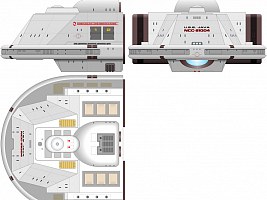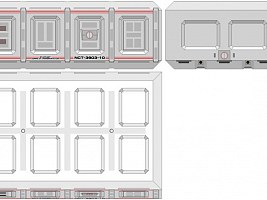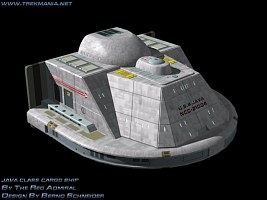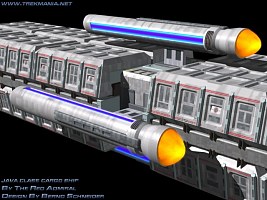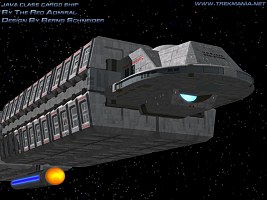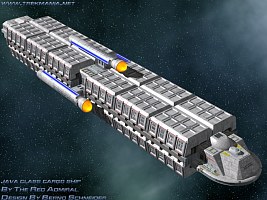Java Class
When replicator technology came into use throughout the Federation, transportation of many finished products became dispensable. Especially simple items for every-day use could be replicated easier than transported over vast distances, even on otherwise little industrialized planets. While the overall volume of interstellar trade kept increasing, the share of finished products dropped from 35% in 2291 to only 8% in 2312. Starfleet reacted to the decreasing need for cargo vessels by postponing the development of the container carrier "Cargo 23" which was supposed to replace a variety of older vessels. 50% of the aged cargo fleet could be retired until 2310, and the relatively new Deneva class was the only container ship to remain in service.
The rapid expansion of the Federation, however, required larger, faster and more economic ships than the Deneva. By 2312, Starfleet reviewed the plans for the "Cargo 23" and decided to build this ship type with minor modifications. The lead ship, the USS Java, was completed in 2320. The Java class uses a new type of angular cargo containers not compatible with the cylindrical type that had been in service for almost 100 years. The payload-to-total mass ratio could be improved by almost 7% with the new containers. There are two different types, the even-numbered having their main latches at the bottom and the odd-numbered on the top, respectively. The interiors of the containers vary considerably, from a version with seven decks and small compartments with individual environmental conditions to a single large compartment measuring 66.5m x 44m x 20.5m. The containers are connected to the ship's frame by the aforementioned latches at their tops or bottoms, respectively. They are connected to each other and are accessible through ports at their front and rear ends. The containers are designed in a way that they can be used by smaller ships too where they are not stacked.
The Java class, in its maximal configuration, is the largest modular ship type in Starfleet and can carry as many as 24 cargo containers with a total useful volume of 1.44 million cubic meters. While single containers may be swapped in a matter of one hour at a starbase, changing the overall configuration of the frame has to be done at a shipyard and takes several days. Therefore the ships usually remain in the same configuration for a long time and cargo containers are only removed if the ship's volume turns out to be underused. About 50% of the ships of the class are currently operated in their maximal configuration. The minimal configuration consists of nothing but the command section, the mid section with the warp nacelles and the aft engineering section. The command section includes the bridge, sickbay, quarters for up to 200 crew and passengers, most sensors, as well as shuttlebays for various auxiliary craft. The mid section with the warp nacelles is mostly uninhabitable. For optimum performance of the nacelles, the same number of containers should be located on either side of this section. The warp core, antimatter storage and a backup control room are located here, as well as two loading ports. The deuterium, on the other hand, is stored in the ship's frame, between the cargo containers. The aft section, besides the impulse engines, has storage compartments for various materials for the ship's operation, as well as for additional cargo.
Since Starfleet doesn't operate their container ships in line service, they are often used for civilian transports too, for instance to erect new colonies. It was planned to develop a mid section for the Java class that could have been used to land the ship (or at least four containers at once) on a planet's surface, but this idea was dropped because its operation turned out to be too expensive and the procedure too complicated to perform in the orbit of an undeveloped planet. Instead of that, a container type with a high-volume transporter was conceived for quick and easy transport to the surface. 23 more ships of this class are owned by civilian trade organizations.
Gallery
Datasheet
| Class specifications Ship type: Cargo ship Length: 568m Width: 142m Height: 99m Crew complement: 30 Max. speed: Warp 6.5 First commissioned in 2320 |
Commissioned ships USS Java NCC-21004 USS Holberg NCC-21005 USS Valdez NCC-21006 USS Scapa Flow NCC-21007 USS Merchantman NCC-21008 USS Flying Dutchman NCC-21009 USS Agulhas NCC-22876 USS Navidad NCC-22877 USS Fugger NCC-22878 USS Copernicus City NCC-24870 USS Manark NCC-24871 USS Regulus NCC-24872 USS Aaron Satie NCC-24873 USS Gobi NCC-24874 USS Gauteng NCC-24875 USS Tyree NCC-24876 USS Delos NCC-24877 USS Lagana NCC-24878 USS Antwerpen NCC-24879 USS Melnos NCC-24880 USS Potomac NCC-24881 USS Lobi NCC-24882 |
Credits
Thanks to The Red Admiral for his 3D model.






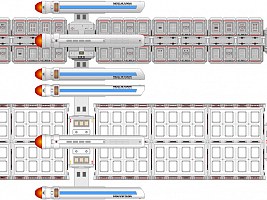
 Detailed three views
Detailed three views